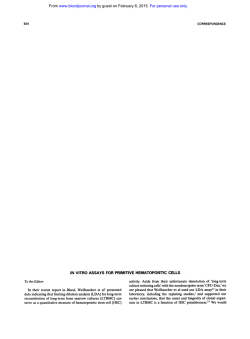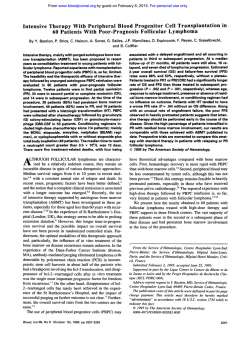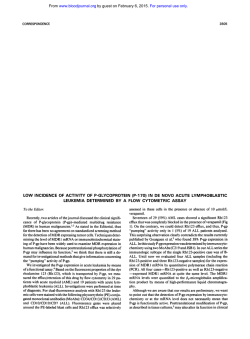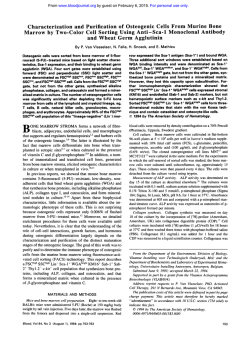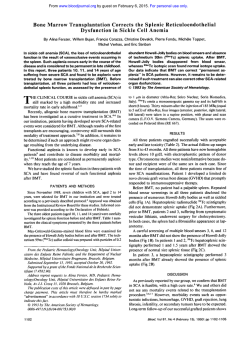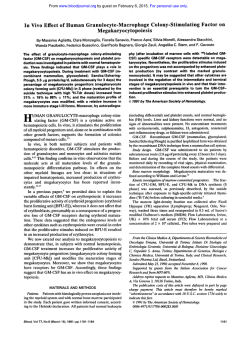
Normal Human Peripheral Blood Mononuclear Cells Mobilized With
From www.bloodjournal.org by guest on February 6, 2015. For personal use only. Normal Human Peripheral Blood Mononuclear Cells Mobilized With Granulocyte Colony-Stimulating Factor Have Increased Osteoclastogenic Potential Compared To Nonmobilized Blood By Louise E. Purton, Minako Y. Lee, and Beverly Torok-Storb Single-cell suspensions of granulocyte colony-stimulating factor (G-CSF)-mobilizedperipheral blood mononuclear cells (G-PBMC) cultured in alpha minimal essential medium ((UMEM)containing 10% fetal bovine serum formed multicellular aggregates within 24 hours. In six separate experiments, formation of aggregates appeared t o be dependent on cell density per surface area, so that 5.8 ? 1.3 aggregates formed per 1 x l o 5 cells when G-PBMC were cultured at densities greater than or equal t o 1 x lo5 cells/cmz. The frequency of aggregate formation was less than 1 per lo5 cells when G-PBMC were cultured at densities less than 1 x I O 5 cellslcm'. Once formed, aggregates became adherent within 72 hours, and then, over the course of 21 days, released CD3lCD41CD25-positive cells into the supernatant. This T-cell production peaked between days 7 and 14, reach- ing a total of 1,269 rt 125.9 cells released per aggregate by day 21. Between days 14 and 21, the aggregates also generated macroscopic clusters of adherent mononuclear and giant multinucleated cells that stained positive for tartrate-resistant acid phosphatase (TRAP). At 4 weeks, the macroscopic foci coalesced into monolayers. Multinucleated TRAP-positive cells were distinguished from macrophage polykaryons by the absence of CD14 expression and the presence of osteoclast-specific membrane receptors for calcitonin and cu,p,-vitronectin. The osteoclast nature of these cells was further demonstrated by their ability t o form resorption lacunae on dentine slices. Comparable osteoclast formation was not detected in cultures of normal marrow or normal nonmobilized peripheral blood. 0 1996 by The American Society of Hematology. 0 late progenitors to form colonies that demonstrate osteoclast characteristics.".I4 However, in these systems, it has been difficult to identify and isolate the osteoclast precursors and to define precisely the factors involved i n the regulation of osteoclast development. In this study, we report the growth of osteoclast progenitors from granulocyte colony-stimulating factor (G-CSF)mobilized peripheral blood mononuclear cells from normal human donors (G-PBMC). The macroscopic clusters of osteoclasts grown from G-PBMC were not detected in cultures of normal marrow or nonmobilized peripheral blood. STEOCLASTS are large, multinucleated cells involved in bone resorption. They are derived from hematopoietic stem cells within the bone marrow, and their precursors can be detected in low frequencies in the peripheral circulation.'.' Osteoclast progenitors are considered to proliferate and differentiate into mononuclear preosteoclasts. Mature osteoclasts form by the fusion of these preosteoclasts into polykaryons, apparently due to local hormonal infl~ences.~.' In vitro, studies of the development and function of osteoclasts have been limited to systems in which cells are grown in the presence of osteoblasts, stroma, growth factors, or hormones."' These studies have demonstrated that osteoclasts can be grown from granulocyte-macrophage colonyforming units, which also give rise to monocytes and macrophages.'".' ' However, the factors influencing the commitment of granulocyte-macrophage colony-forming units into osteoclast progenitors are unclear. It appears that la,2S-dihydroxyvitamin D3 has a role in increasing osteoclast differentiation,'* and osteoclasts are grown in the presence of this vitamin in most culture systems in which they are currently studied. '.'" Furthermore, a murine osteoclastspecific colony-stimulating factor has been isolated from a murine mammary carcinoma and shown to selectively stimu- From the Program in Transplantution Bivlogy, Clinicuf Resetirch Division, Fred Hutchinson Cancer Research Center, und the Departments of Biological Structure and Medicine, Universiiy vf Washington, Seattle, WA. Submitted June 12, 1995; accepted October 16, 1995. Supported by Grants No. DK34431, CA18221, CA18029, and HL36444 from the National Institutes .;fHealth, Department of Health and Human Services, Bethesda. MD. Address reprint requests to Louise E. Purton, PhD, Fred Hutchinson Cancer Research Center, I124 Columbiu St, M-318, Seattle. WA 98104. The publication costs of this article were defrayed in part by page charge puyment. This urticle must t h e r e j k be hereby marked "advertisement" in uccordance with 18 U.S.C. section I734 solely to indicate this ,fact. 0 1996 by The American Society of Hematology. 0006-497//96/8705-0018$3.00/0 1802 MATERIALS AND METHODS Donors, marrow. and peripherul blood mononuclear celi processing. Marrow, nonmobilized PBMC, and G-PBMC were obtained from normal donors after provision of informed consent as defined by the Internal Review Board at the Fred Hutchinson Cancer Research Center (Seattle, WA). G-PBMC donors were mobilized with recombinant human G-CSF at 16 wg/kg/d (Amgen Inc, Thousand Oaks. CA) by administering two subcutaneous injections per day for 5 days, 4 days before G-PBMC collection and once after the first collection. Leukapheresis was performed using a continuousflow blood cell separator (Cobe Laboratories, Lakewood, CO) on 2 consecutive days beginning on day S of rhG-CSF administration. Samples for experiments were taken either from the first or second day of collection. Cells were suspended in Hanks balanced salt solution ([HBSS], GIBCO, Gaithersburg, MD) and centrifuged at 200 X g for 6 minutes to remove platelets before hemolysis in hemolysis buffer (ammonium chloride I SO mmol/L, and sodium bicarbonate I2 mmol/L). Marrow was obtained from allogeneic donors by aspiration from the iliac crest under general anesthesia. Samples were collected into 10% Normosol R (Abbott Laboratories, North Chicago, IL) supplemented with I O IU/mL preservative-free heparin. Cells were suspended in HBSS and centrifuged at 200 X g for 10 minutes to remove platelets before hemolysis in hemolysis buffer. Culture conditions. Hemolyzed huffy coat preparations of each population were suspended in alpha minimal essential medium ([uMEM] GIBCO) supplemented with 10% fetal calf serum (FCS). penicillin (100 U/mL), and streptomycin sulfate (100 p,g/mL) (complete aMEM). Viability of the cells was assessed by trypan blue exclusion, The cultures were established at varying cell concentraBlood, Vol 87,No 5 (March l), 1996:pp 1802-1808 From www.bloodjournal.org by guest on February 6, 2015. For personal use only. OSTEOCLASTS IN G-PBMC 1803 t Ir Fig 1. Formation of osteoclasts from aggregatesderived from G-PBMC. Inverted phase-contrast micrographs show (AI attached aggregates at 48 hours of culture after nonadherent cells were removed (original magnification ~ 1 0 0 )(BI . release of T lymphocytes from aggregates at 10 days of culture (original magnification x 100). (C) resolution of aggregates and emergence of large multinucleated cells at 18 days (original magnification x400). and (D) growing foci of adherent cells at day 28. Giant multinucleated cells are evident (original magnification ~ 4 0 0 ) . tions, with optimal growth obtained at 5 X IO6 viable cells/well in six-well plates (Costar, Cambridge, MA). Cultures were placed in incubation at 37°C with 5% CO2 in air atmosphere. After 3 days, nonadherent cells were removed from the cultures. Adherent populations were washed three times with HBSS and then fed with complete (uMEM and returned to incubation. Cultures were fed every 3 to 4 days with complete (uMEM. Analysis of nonadherent cells produced bv the cultures. Adherent cells were cultured for 7 days, washed in HBSS, and refed with complete (rMEM. Nonadherent cells were then retrieved from these cultures at 3- to 4-day intervals. These cells were centrifuged (400 8 for IO minutes), supernatant was removed, and the cells were incubated with normal mouse serum to block nonspecific binding sites. Cells were then stained with Leu4 (phycoerythrin [PE]-conjugated mouse IgGl anti-CD3; Becton Dickinson, San Jose, CA), fluorescein isothiocyanate (FITC)-conjugated mouse IgG 1 anti-CM (Amac Inc. Westbrook, ME), FITC-conjugated mouse IgG 1 antiCD25 (Becton Dickinson), and PE-conjugated mouse IgG2a antiHLA-DR (Becton Dickinson). Staining was performed for 20 minutes on ice. Control staining was performed simultaneously using isotype-matched, irrelevant antibodies directly conjugated to FITC and PE. Cells were washed twice in HBSS/l% bovine serum albumin (BSA) and analyzed on a FACSCAN flow cytometry system (Becton Dickinson). From www.bloodjournal.org by guest on February 6, 2015. For personal use only. PURTON, LEE, AND TOROK-STORB 1804 control FlTC CD25 FlTC .. CD4 FITC CD25 FlTC Fig 2. flow cytofluorometric analysis of viable nonadherent cells releasedfrom adherent aggragates in G-PBMC cultures. Histograms represent twocolor analysis of cells contained within a forward and orthogonal light-scattering gate established to exclude dead cells (not shown). Histograms as labeled indicate that nonadherent cells express CD3, CD4, CD25, and HLA-DR vcontrol calls incubatedsimultaneously with irrelevant mouse IgGl-FITC, IgG1-PE, and IgG2a-PE. Phenotypical analysis by cytochemical staining. Cultured cells were stained for tartrate-resistant acid phosphatase (TRAP) activity. Cell populations were washed three times in phosphate-buffered saline (PBS), fixed in 10% (voVvol) neutral buffered formalin, and air-dried. Populations were then preincubated for 1 hour at 37°C in a 0.2-mom Tris-buffered solution (pH 9.0) and stained for TRAP activity in the presence of 10 mmol/L L(+)-tartaric acid (Sigma Chemical CO, St Louis, MO) as previously des~ribed.'~.''Cells containing TRAP activity stained a distinctive red color. Analysis of calcitonin receptor expression. The presence of calcitonin receptors on the cells was investigated according to a previously described method.16Cells were grown on eight-well chamber slides for 2 weeks. Populations were then incubated with 0.2 nmoVL human '251-calcitonin(specific activity, 1,634 Ci/mmolL, Peninsula Labs, Belmont, CA) in aMEM containing 0.1% BSA for 1 hour at room temperature. Nonspecific binding was assessed by adding an excess amount (300 nmol/L) of unlabeled human calcitonin (Sigma Chemical CO) to some chambers. Background was estimated by incubating some wells in medium alone. After labeling, the populations were washed in cold PBS and then fixed in 10% neutral buffered formalin. The dried slides were then coated with NBT-2 emulsion (Kodak, Rochester, NY), exposed in the dark at 4°C for 2 weeks, and developed. Cells were counterstained with Diff-Quik Solution I1 (American Scientific Products, McGaw Park, IL) and evaluated for calcitonin receptor expression using a Zeiss (Oberkochen, Germany) Axiovert 35 inverted light microscope. Expression of the vitronecrin receptor. The monoclonal antibody, 23C6 (kindly provided by Dr Michael A. Horton, London, England) recognizes the integrin a,/&vitronectin receptor that is present on the membranes of osteoclasts."~'* The presence of this antigen on each of the cell populations was determined by indirect immunofluorescence using a biotin-streptavidin-FITC coupling method. Cells were grown on eight-well chamber slides, washed in PBS, and fixed in 2.5% paraformaldehyde in 0.1 m o m phosphate buffer containing 4% sucrose. The cells were first incubated in 1% BSA in PBS for 30 minutes, and then incubated with mouse IgGl antihuman 23C6 diluted 1:50 or an isotype-matched irrelevant primary antibody for 40 minutes at 4°C. The cells were washed in PBS three times and then incubated at m m temperature with a biotinconjugated goat antimouse IgG (Southern Biotechnology Associates, Inc. Birmingham, AL), diluted 1:20 in PBS/I% BSA for 30 minutes, followed by an FITC-conjugated streptavidin (Southern Biotechnology Associates, Inc), diluted 1:20 in PBS for 1 hour. Cell autofluorescence and nonspecific binding of the biotin-streptavidin-FITC were also investigated. Nuclei were counterstained with 1 pg/mL 4', 6diamidine-2 phenylindoledihydrochloride (DAPI). Human foreskin fibroblasts were used as a negative control. The cells were washed thoroughly, mounted, and analyzed using a Deltavision SA3 wide-field deconvolution microscope (Applied Precision, Inc, Mercer Island, WA) coupled to a cooled-CCD camera (Photometrics, Inc. Tucson, AZ)under a Nikon 60X objective (Chiyoda-Ku, Tokyo, Japan). Color images were transferred to the Macintosh-based program Photoshop 2.5 (Adobe Systems, Mountain View, CA), from which they were printed as hard copies using a Phaser IISD color printer (Tektronix, Beaverton, OR). Analysis of myeloid and lymphoid antigens. Direct immunofluorescence was used to examine the presence of myeloid and lymphoid antigens over the first 2 weeks of culture. The cells were first incubated in 1% BSA in PBS for 30 minutes and then incubated with a PE-conjugated LeuM3 mouse IgG2b anti-CDl4 (Becton Dickinson) diluted 1:20 or an FITCconjugated IOT3b mouse IgGl anti-CD3 (Amac, Westbrook, ME) diluted 1:20 for 30 minutes at 4°C. The cells were washed in PBS three times, and the nuclei were stained with DAPI (1 pg/mL,). Controls included staining with isotype-matched nonbinding irrelevant primary antibodies. The cells were fixed in 2.5% paraformaldehyde in 0.1 mol/L PBS containing 4% sucrose, mounted, and viewed by confocal microscopy as described earlier. Demonstration of resorption lacunae. Sterilized dentine slices (8 x 8 x 0.1 nun) were prepared from cow teeth and placed at the bottom of Costar 48-well plates. G-PBMC were plated over the dentine slices at a density of 1 x IO6 cells/well, in complete aMEM. These cultures were incubated, as already specified, for 21 days. The supernatant was then removed, and dentine slices were washed in PBS. Cells were removed from the dentine by immersing the slices in B Fig 3. Osteoclast characteristics of mononuclaar and multinucleated cells grown from G-PBMC aggregates. (A and B) Expression of the integrin a.&-vihonectin receptor by multinucleated cells. Specific binding of antivitronectln receptor monoclonal antibody 23C6 is revealed by green fluorescence after incubation with goat antimouse IgG-biotin and avidin-FITC (A). Only DAPI-stained nuclei are apparent in control G-PBMC populations incubated with an isotype-matched, nonbindingcontrol antibody plus biotintonjugated goat antimouse IgG and avidinFITC IB) (original magnification ~400). (C) TRAP staining of adherent cells revealsthat many mononuclear precursors and large multinucleated cells are TRAP-positive, as indicatedby the red color (original magnification ~ 4 0 0 )ID . and E)Autoradiographyof ['"ll-human calcitonin binding to cultures of G-PBMC. Many grains are seen localized over the multinucleated cell incubated with ['%human calcitonin in the absence of excess unlabeled calcitonin (D). In the presence of excess unlabeled human calcitonin, only background grains are detected (E) (original magnification x500). From www.bloodjournal.org by guest on February 6, 2015. For personal use only. OSTEOCLASTS IN G-PBMC L! 1805 From www.bloodjournal.org by guest on February 6, 2015. For personal use only. PURTON, LEE, AND TOROK-STORB 1806 50% (vollvol) sodium hypochlorite in distilled water for 30 minutes at room temperature. Dentine slices were then washed in distilled water, briefly sonicated, dehydrated in ethanol. and air-dried. Mounted samples were sputter-coated with 15 nm gold and viewed in a Jeol JSM-840A scanning microscope (Peabody, MA)." RESULTS Normal donor G-PBMC cultured in complete aMEM formed nonadherent aggregates within 24 hours. Within 72 hours, the aggregates adhered to the culture plates (Fig IA). In six experiments using different sources of G-PBMC, aggregate formation occurred at a frequency of 5.8 t 1.3/10s cells when cells were plated at a density of 1 X IO' to I X 10" cells/cm'. At less than an initial plating density of 1 X 10" cellslcm', the frequency decreased to less than 1/10' cells. The aggregate formation observed with G-PBMC was not detected in cultures of normal peripheral blood or marrow; however, single large, multinucleated, TRAP-positive cells could be grown from both of these cell sources. However, these were rare events, occurring at a frequency of less than 1/10" cells plated. Once the aggregates present in G-PBMC were attached and it was possible to remove all nonadherent cells, it became apparent that small round nonadherent cells were being generated by the aggregates (Fig 1B). The newly produced nonadherent cells, collected and analyzed by immune cytochemistry and flow cytometry, were found to express CD3, CD4, CD25, and HLA-DR, suggesting they were activated T lymphocytes (Fig 2). The adherent aggregates continued to generate T cells for approximately 4 weeks. In three separate experiments using three different sources of G-PBMC, the number of aggregates formed by 5 X lo6 cells plated in a IO-cm2surface area was 327 2 45.42. In these experiments, the number of T cells generated between days 7 and 14 of culture was 877.6 +- 125.9 per aggregate. Between days 14 and 21, production decreased to 392 ? 31.5 per aggregate, and from days 21 to 28 it was 20.3 2 6.8 per aggregate. Between 1 and 2 weeks of culture, large multinucleated cells with clear cytoplasm became visible under the aggregates (Fig 1C). Many of these cells appeared to be formed by cell fusion. The number of these giant fused cells increased with time over a period of 4 weeks. During this time, the aggregates resolved into complex monolayers (Fig ID). These cells adhered strongly to the culture flasks, and this adhesion was trypsin-resistant. The osteoclast identity of the cultured cells was demonstrated by their expression of the vitronectin receptor (Figs 3A and 3B). cytoplasmic TRAP activity (Fig 3C), and the presence of calcitonin receptors (Figs 3D and E). In contrast, these cells were negative for the myeloid antigen CD14 (data not shown). Finally, after 21 days of culture, the candidate osteoclasts were capable of forming resorption lacunae on dentine slices, hence demonstrating the essential features of osteoclasts (Fig 4). Different media were tested for their ability to support the growth of the osteoclasts. The medium supporting optimal growth of osteoclasts was aMEM containing 10% FCS. Formation of these cells was supported to a lesser degree by Fig 4. Scanning electron microscopy of a dentine slice cocultured with aggregates formed from G-PBMC, showing two resorption lacunae. The smaller patterned recesses are dentinal tubules (original magnification ~ 8 5 0 ) . RPMI (GIBCO) containing 10% FCS, but not by long-term culture media that contains horse serum and calf serum." medium 199 (GTBCO) containing 20% FCS, or serum-deprived medium containing 1% Nutridoma (Boehringer Mannheim, Indianapolis, IN). DISCUSSION This study describes a method by which macroscopic clusters of osteoclasts can be grown in culture from their progenitors in the absence of stromal cells, cell lines, growth factors, or la,25-dihydroxyvitamin D3. Growth of large clusters of osteoclasts was associated with cell aggregates, the formation of which was dependent on the number of cells plated per surface area. Optimal growth occurred in aMEM containing 10% FCS. with G-PBMC plated at 5 x 10' cells/well in a six-well plate. Under these conditions, 327 ? 45.2 macroscopic foci of osteoclasts were detected per well. Multinucleated osteoclasts were distinguished from macrophage polykaryons by the presence of osteoclastspecific membrane receptors for calcitonin and the integrin a,p,-vitronectin, and by expression of TRAP. Functionally, these cells were capable of forming resorption lacu- From www.bloodjournal.org by guest on February 6, 2015. For personal use only. OSTEOCLASTS IN G-PBMC 1807 ACKNOWLEDGMENT nae on dentine slices, hence confirming their osteoclast nature. In addition, these cells did not express the myeloid The authors sincerely thank Paul Goodwin and Tim Knight for antigen, CD14, which has been shown to be present on assistance with image analysis, Liz Caldwell for assistance with giant macrophages but not on human osteoclasts.20Formascanning electron microscopy, and Bonnie Larson, Julie Sentkowski, tion of mature, multinucleated osteoclasts appeared to ocand Harriet Childs for preparing the manuscript. cur by cell fusion, in agreement with previous investigat i o n ~ . ~ .These ’~ mononuclear progenitors were also REFERENCES positive for all of the osteoclast markers examined, in 1. Suda T, Takahashi N, Martin TJ: Modulation of osteoclast accordance with other reports.l6,” differentiation. Endocr Rev 13:66, 1992 Osteoclasts could also be grown from normal peripheral 2. Scheven BAA, Visser JWM, Nijweide PJ: In vitro osteoclast blood and marrow under the given culture conditions; generation from different bone marrow fractions, including a highly enriched haematopoietic stem cell population. Nature 321:79, 1986 however, they occurred as single, relatively rare osteo3. Walker DG: Osteopetrosis cured by temporary parabiosis. Sciclasts, not as large clusters of osteoclasts as seen with Gence 180:875, 1973 PBMC. In the current study, osteoclasts in all cultures 4. Ash P, Loutit JF, Townsend KMS: Osteoclasts derive from formed in the absence of l a , 25dihydroxyvitamin D3, hematopoietic stem cells according to marker, giant lysosomes of contradicting previous observation^.^,^ Our results indicate beige mice. Clin Orthop Re1 Res 155:249, 1981 that vitamin D3 is not required for osteoclast formation. 5. Baron R, Neff L, Tran Van P, Nefussi JR, Vignery A: Kinetic Osteoclast precursors arise in the marrow and migrate in and cytochemical identification of osteoclast precursors and their the body via the circulation. It is not surprising therefore differentiationinto multinucleated osteoclasts. Am J Path01 122:363, that these cells can be grown from peripheral blood and 1986 marrow. However, it would appear that osteoclast precursors 6. Roodman GD, Ibbotson KJ, MacDonald BR, Kuehl TJ, Mundy in G-PBMC differ either qualitatively or quantitatively from GR: 1,25-Dihydroxyvitamin D3 causes formation of multinucleated those in marrow or normal blood, since the aggregate formacells with several osteoclast characteristics in cultures of primate marrow. Proc Natl Acad Sci USA 82:8213, 1985 tion that precedes development of large clusters of osteo7. Fuller K, Chambers TJ: Generation of osteoclasts in cultures clasts did not occur with cells from these other sources. The of rabbit bone marrow and spleen cells. J Cell Physiol 132:441, mechanisms responsible for increased detection of osteoclast 1987 progenitors in G-PBMC are unknown. However, it is reason8. Takahashi N, Akatsu T, Udagawa N, Sasaki T, Yamaguchi A, able to speculate that the marrow hypercellularity induced Moseley JM, Martin TJ, Suda T: Osteoblastic cells are involved in by G-CSF may stimulate production of osteoclasts in an osteoclast formation. Endocrinology 123:26OO, 1988 effort to remodel bone and accommodate hematopoiesis. The 9. Udagawa N, Takahashi N, Akatsu T, Tanaka H, Sasaki T, reported increase in osteoporosis seen in some chronic neuNishihara T, Koga T, Martin TJ, Suda T: Origin of osteoclasts: tropenic patients receiving G-CSF therapy supports this hyMature monocytes and macrophages are capable of differentiating pothesis.** into osteoclasts under a suitable microenvironment prepared by bone Although mobilization by rhG-CSF appears to be crucial marrow-derived stromal cells. Proc Natl Acad Sci USA 87:7260, for the formation of these osteoclast progenitors, it is un1990 10. Kurihara N, Suda T, Miura Y, Nakauchi H, Kodama H, Hiura likely that G-CSF has a direct effect on the formation of K, Hakeda Y,Kumegawa M: Generation of osteoclastsfrom isolated these clusters, since a previous study has indicated that it hematopoietic progenitor cells. Blood 7 4 1295, 1989 does not stimulate formation of TRAP-positive colonies 1 1. Hattersley G, Kerby JA, Chambers TJ: Identification of osteofrom murine hematopoietic ~ e l 1 s . lHowever, ~ it is possible clast precursors in multilineage hemopoietic colonies.Endocrinology that the different cellular composition of G-PBMC versus 128:259, 1991 normal peripheral bloodz3 is a critical factor. G-PBMC could 12. Suda T, Takahashi N, Abe E: Role of vitamin D in bone contain a greater number of osteoclast precursors, making resorption. J Cell Biochem 4953, 1992 the likelihood of aggregate formation greater. Alternatively, 13. Lee MY, Eyre DR, Osbome WRA: Isolation of a murine there could be qualitative differences among G-PBMC that osteoclast colony-stimulating factor. Proc Natl Acad Sci USA favor osteoclast development. 88:8500, 1991 In this regard, the production of CD4-positive T lympho14. Lee MY, Lottsfeldt JL, Fevold KL: Identification and characcytes in G-PBMC cultures is of interest, since other investiterization of osteoclast progenitors by clonal analysis of hematopoigations have shown that lymphocytes are capable of supportetic cells. Blood 80:1710, 1992 15. Liu C, Sanghvi R, Bumell JM, Howard GA: Simultaneous ing the differentiation of osteoclasts. Lymphoid culture demonstration of bone alkaline and acid phosphatase activities in conditions have been shown to support the production of plastic-embedded sections and differential inhibition of the activities. murine colony-forming unit osteoclast^,^^ and interleukin-3 Histochemistry 86559, 1987 secreted by activated T lymphocytes has been implicated as 16. Takahashi N, Akatsu T, Sasaki T, Nicholson GC, Moseley being involved in both increasing the number of marrow JM, Martin TJ, Suda T: Induction of calcitonin receptors by l a , 25cells that become TRAP-positive and inducing the fusion of dihydroxyvitamin D, in osteoclast-like multinucleated cells formed TRAP-positive mononuclear cells into p o l y k a r y o n ~ . ~ ~ from mouse bone marrow cells. Endocrinology 123:1504, 1988 Whether G-PBMC have a greater number of osteoclast pro17. Horton MA, Lewis D, McNulty K, Pringle JAS, Chambers TJ: genitors, a more favorable accessory function, or both, reMonoclonal antibodies to osteoclastomas (giant cell bone tumors): mains to be determined. Nevertheless, these studies show Definition of osteoclast-specific cellular antigens. Cancer Res that relatively pure cultures of osteoclasts can be obtained 455663, 1985 from G-PBMC. 18. David J, Warwick J, Horton M: Biochemical characterization From www.bloodjournal.org by guest on February 6, 2015. For personal use only. 1808 of human osteoclast-specific antigens defined by monoclonal antibodies 13c2 and 23c6. J Bone Miner Res 1:4, 1986 (abstr) 19. Roecklein BA, Torok-Storb B: Functionally distinct human marrow stromal cell lines immortalized by transduction with the human papilloma virus E6E7 genes. Blood 85:997, 1995 20. Athanasou NA, Alvarez JI, Ross FP, Quinn JM, Teitelbaum SL: Species differences in the immunophenotype of osteoclasts and mononuclear phagocytes. Calcif Tiss Int 50:427, 1992 21. Kurihara N, Chenu C, Miller M, Civin C, Roodman GD: Identification of committed mononuclear precursors for osteoclastlike cells formed in long term human marrow cultures. Endocrinology 126:2733, 1990 22. Bishop NJ, Williams DM, Compston JC, Stirling DM, Pren- PURTON. LEE, AND TOROK-STORB rice A: Osteoporosis in severe congenital neutropenia treated with granulocyte colony-stimulating factor. Br J Haematol 89:927, 1995 23. Dreger P, Haferlach T, Eckstein V, Jacobs S, Suttorp M, Loffler H, Muller-Ruchholtz W, Schmitz N: G-CSF-mobilized peripheral blood progenitor cells for allogeneic transplantation: Safety, kinetics of mobilization, and composition of the graft. Br J Haematol 87:609, 1994 24. Lee TH, Fevold KL, Muguruma Y, Lottsfeldt JL, Lee MY: Relative roles of osteoclast colony-stimulating factor and macrophage colony-stimulating factor in the course of osteoclast development. Exp Hematol 22:66, 1994 25. Barton BE, Mayer R: E-3 induces differentiation of bone marrow precursor cells to osteoclast-like cells. J Immunol 143:321 l , 1989 From www.bloodjournal.org by guest on February 6, 2015. For personal use only. 1996 87: 1802-1808 Normal human peripheral blood mononuclear cells mobilized with granulocyte colony-stimulating factor have increased osteoclastogenic potential compared to nonmobilized blood LE Purton, MY Lee and B Torok-Storb Updated information and services can be found at: http://www.bloodjournal.org/content/87/5/1802.full.html Articles on similar topics can be found in the following Blood collections Information about reproducing this article in parts or in its entirety may be found online at: http://www.bloodjournal.org/site/misc/rights.xhtml#repub_requests Information about ordering reprints may be found online at: http://www.bloodjournal.org/site/misc/rights.xhtml#reprints Information about subscriptions and ASH membership may be found online at: http://www.bloodjournal.org/site/subscriptions/index.xhtml Blood (print ISSN 0006-4971, online ISSN 1528-0020), is published weekly by the American Society of Hematology, 2021 L St, NW, Suite 900, Washington DC 20036. Copyright 2011 by The American Society of Hematology; all rights reserved.
© Copyright 2025

